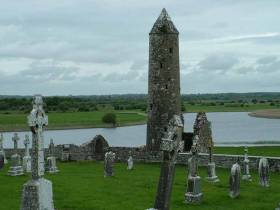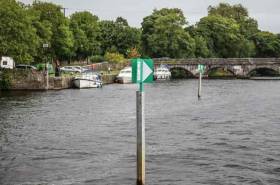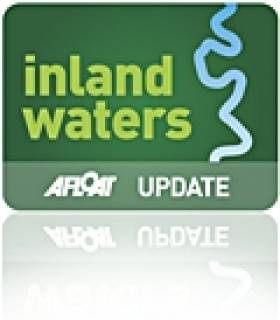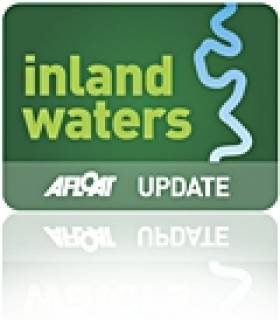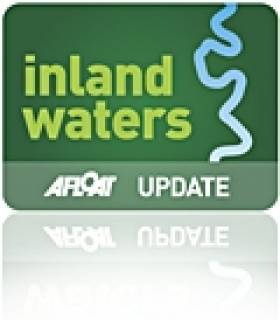Displaying items by tag: IWAI
For the first time a St Patrick’s Day Parade has picked the Inland Waterways as the Parade theme. The IWAI has congratulated the Tullamore Parade Committee on their choice.
By selecting this theme the Parade will highlight the importance of Offaly’s Inland Waterways to the communities through which they flow. In addition to showcasing a variety of water-based activity, the Parade theme will also encourage participants to display their interpretation of the history of these Waterways. Secretary of the Parade Committee Sean O'Brien captures this feeling noting that;
“The Grand Canal has been flowing through Offaly for over 200 years and it has had a significant influence on the business, cultural, heritage and leisure life of the County and its Towns. This is a great opportunity to celebrate this impact and this great facility and we hope that many more people will use the facility over the coming years."
The IWAI has been extended a great honour with an invitation to the President John Dolan to act as Grand Marshall for the Parade. The Tullamore Parade is well-established with over 1,500 participants and up to 10,000 onlookers. While the Parade itself starts at 11.30a.m, proceedings get underway at approx. 10:30am. A flotilla will ferry the dignitaries from Bolands Lock House to the Tullamore Dew Heritage Centre. This flotilla will include members of the Tullamore Canoe Club, the Offaly Rowing Club and the IWAI Offaly Branch. Floats in the Parade will feature the IWAI Offaly Big Bolinder Engine and a variety of vessels including a 13 metre four man rowing boat, a speed boat and a powerboat.
County Offaly is a haven for Inland Waterways and includes lakes, rivers & canals. The Grand Canal, stretching from near Edenderry to Shannon Harbour, winds its way timelessly through the countryside. On reaching Shannon Harbour, one enters onto the mighty River Shannon whose waters form the natural border between Galway & Offaly. From above Meelick in the south of the County towards Athlone in the North, Offaly’s Shannon Waterways boast many treasures including the religious, cultural & historically significant site of Clonmacnoise
Water Abstraction Will Affect Entire Shannon Navigation – IWAI
The Inland Waterways Association of Ireland (IWAI) has responded to Irish Water’s third Public Consultation on the Preferred Option to abstract water from Parteen Basin to service the East and Midlands region.
In its submission IWAI has again expressed grave concerns over the impact that this abstraction will have, not just on Lough Derg, but on the entire Shannon Navigation.
In an effort to mitigate this risk, IWAI puts forward the view that water levels should be monitored and controlled by a single authority, that weirs on the River Shannon should be automated and that flow levels at weirs should be collated and presented by way of a public web portal.
The full IWAI submission, compiled by Association Past Presidents Gregory Whelan and Carmel Meegan, is attached below.
Free Boat Trips In Meath Thanks To Inland Waterways Association of Ireland Boyne Branch
The Boyne Navigation branch of the Inland Waterways Association of Ireland (IWAI) held their annual Open Day on Sunday, 28th August, 2016, to coincide with National Heritage Week. The Open Day was IWAI Boyne Navigation’s biggest event of the year.
Boat trips started at the restored sea lock at Oldbridge - Lock 1 where everybody entering a boat was provided with a lifejacket. The journey took passengers along this stretch of the waterway up by Oldbridge Estate.
Demand for the trips was high with an estimated turnout of 500 people. Due to the level of interest from members of the public, the plan to run boat trips from 2-5pm had to be extended to 6:30pm.
Refreshments and food was provided free of charge by Maeve, Marie and their band of helpers in the Lock House garden and a designated car park was provided on the grounds of Oldbridge Estate.
IWAI Boyne Navigation is a voluntary group who are making great strides in the restoration of the Boyne Canal. The Canal interlinks with the River Boyne to connect the towns of Navan & Slane to Drogheda & the sea beyond.
Volunteer workers have now moved on to the Staleen or second section of waterway. IWAI Boyne Navigation hopes that many of the people that attended the Open Day on Sunday, 28th will support the restoration efforts by becoming members or simply by making a donation.
At the recent AGM in Tullamore of the Inland Waterways Association of Ireland (IWAI) Mr. John Dolan was elected as the Association’s 18th President, taking over the helm from Ms Carmel Meegan.
John has been very active on our inland waterways over a great many years both at Executive and branch level. John has served as IWAI Vice President since 2014 and has previously held the role of Liaison & Lobbying Officer and PRO on the IWAI Executive.
At local level John is a member of IWAI Offaly where he has fulfilled numerous roles including Chairperson and Vice Chairperson. John has been instrumental in highlighting the potential of the Grand Canal for tourism development in recent years. This has resulted in the development of Tullamore as a focal point for major festivals including Fleadh Cheoil na hÉireann and the Johnny Keenan Banjo Festival.
John has also worked tirelessly with the local political and business community in Offaly to promote events including Discover the Grand Canal Cruise in Company and the Grand Canal Offaly Floating Festival or Grand COFF.
On a national level, John has played a key role on the IWAI Canals Action Group. This subcommittee has liaised with IWAI members, canal communities, local businesses along the canals corridor and local and national politicians to ensure that Bye law changes proposed by Waterways Ireland for the Grand Canal, Royal Canal & River Barrow Navigation put user requirements, tourism development and local communities at the centre of the regulations.
In his address as incoming President John Dolan thanked the outgoing President and the IWAI Executive for all of their work in recent years. In looking forward to his own term of office, Mr Dolan cited several opportunities where IWAI can influence the governance and development of our Inland Waterways including Canal Bye-laws & Water Abstraction. He also noted that IWAI as an Association can develop over the next few years the preservation of the IWAI’s past for the future, attract future generations to become IWAI members & broaden the IWAI ethos and message to new audiences.
Also at the AGM Mr Alan Kelly was elected as IWAI Vice President, succeeding John Dolan in that role. Alan is a native of Dublin and has been an active member of IWAI Kildare since 2003.
Inland Waterways Association of Ireland Canal Bill Election Campaign Gathers Pace
Election Candidates nationwide have being contacting the Inland Waterways Association of Ireland (IWAI) to pledge their support for an IWAI call for provision to be made for new canal bye-laws via a dedicated Canal Bill during the next Dáil, according to the IWAI.
This campaign allows Candidates an opportunity to publically demonstrate their support for the Canals and their Communities and their efforts to encourage the use and growth of the canals with legislation that is centred on the communities, users and tourism.
The pledge to date is receiving good cross party support. The IWAI web team will be updating local and national media next week on candidates supporting the pledge.
The pledge:
"IWAI request election candidates to pledge their support for an IWAI call for provision to be made for new canal bye-laws via a dedicated Canal Bill during the next Dáil when possible rather than including any future legislation in a joint Bill such as the Heritage bill 2016. Furthermore in developing The Canal (Amendment) Bill 2017 that recognition be given to the canal users, canal communities and Local Authorities adjoining the canals by way of prelegislative
consultation and scrutiny. This approach would be in line with Government reform and best practice."
Background
With no advance notice or consultation with the inland waterways stakeholders & canal communities the Heritage Bill 2016 was published on 4 January 2016.
IWAI advised that while it would welcome and support proper regulations the proposed Bill did not put user requirements, local communities or tourism at the centre of the regulations. Rather the now lapsed bill is a heavy handed approach that will result in lower boat traffic on the canals.
Prior to the 2016 Bill, in January 2014 Waterways Ireland brought forward proposals for amendments to the Canal Byelaws 1988 under the Canals Act 1986 & Maritime Safety Act 2005. IWAI campaigned vigorously during the minimal consultation period of 21 days. Public discussion in 2014 on the matter included - the Canals and Barrow as a tourism resource; queries raised in the Seanad and the Dail; County Councils input; public meetings; national and local press articles; television and radio interviews; community websites; blogs and facebook pages. These all reflected the reservations of users, communities and public representatives as to the significant impact of the draconian suggestions in the proposed bye-laws.
The IWAI campaign resulted in an invite to appear before the Oireachtas Joint Committee on Environment, Culture and the Gaeltacht.
Feedback from members of this cross party Committee who met on 25 March 2014 included:
• “I am fearful that proposals will be implemented without further recommendations” - Senator Cait Keane. Fine Gael Labour Panel.
• “I am of the view that Waterways Ireland must return to the beginning and reconsider this matter from a very practical viewpoint. What is proposed is going to lead to the closure of the Canal” - Deputy James Bannon. Fine Gael Longford - Westmeath
• “People should not feel pushed out of an activity they have grown up with, love and wish to pass on to other generations and the community to help local economies with the tourism income it can provide” -
Deputy Barry Cowen. Fianna Fail Laois - Offaly
• “The Bye-laws will impact heavily on a small number of people” - Deputy Catherine Murphy. Independent Kildare North
• “The huge increase in some fees is unacceptable and there is serious concern that the proposed fees will
damage tourism and drive people from the waterways” Deputy Sandra McLellan. Sinn Fein Cork East
• “The new bye-laws will make exacting demands on users of the Canal” - Deputy Seamus Kirk. Fianna Fail. Louth
• “The five day rule, which I believe is completely unworkable” - Deputy Ann Phelan. Labour Carlow Kilkenny
The 2014 proposed byelaws if passed would not have had any validity as noted this year on the Waterways Ireland website “The Minister was subsequently advised by the Office of the Attorney General that amendments to the primary legislation governing the bye-laws (the Canals Act 1986) would be necessary to ensure that the new bye-laws would not be ultra vires.” The proposed invalid bye-laws were published with no prior consultation and a short public consultation period of just 21 days, resulted in over 2300 submissions on the issue.
The current position
Two years later and it seems no lessons have been learned on how to communicate with the customer and communities along the canals.
The powers proposed within the new Act will affect those on the waterways of Carlow, Dublin, Kildare, Kilkenny, Laois, Longford, Meath, Offaly and Westmeath. The bill had Stage 2 approval in the Seanad, but is now lapsed due to the dissolution of the Dáil this month.
Future Outlook
Politically, this is now a very big issue. It is going to feature highly as candidates face into elections this spring. The IWAI have gained the interest of local, regional and national politicians on this matter to date, who on behalf of their constituents, want to develop, not constrict, canal use.
'Prohibitive Legislation Set to Stifle Canal Development' – IWAI
The Inland Waterways Association of Ireland (IWAI) fear reduced services and prohibitive enforcement practices including stop and search provisions by Waterways Ireland Authorised Officers as a result of the new Heritage Bill published this week.
With no advance notice or consultation with the inland waterways stakeholders & canal communities the Heritage Bill 2016 was published on 4 January 2016. Part 2 deals with amendments to the Canal Act 1986. Minister for Arts Heritage and the Gaeltacht Heather Humphreys in introducing the bill to the Seanad at Stage 2 this week stated “it is a robust framework for the making of bye-laws to regulate the use of boats on the canals and the management of canals and canal properties. These changes will enhance the ability of Waterways Ireland to manage waterways for the benefit of all”
IWAI advise that while it would welcome and support proper regulations the proposed Bill does not put user requirements, local communities or tourism at the centre of the regulations. Rather it is a heavy handed approach that will result in lower boat traffic on the canals. Boats will opt to move to the other Irish Waterways also managed by Waterways Ireland, where the regulations are more user friendly and where there are no oppressive fines and penalties.
Background to this Bill
In January 2014 Waterways Ireland brought forward proposals for amendments to the Canal Byelaws 1988 under the Canals Act 1986 & Maritime Safety Act 2005. IWAI campaigned vigorously during the minimal consultation period of 21 days. Public discussion in 2014 on the matter included - the Canals and Barrow as a tourism resource; queries raised in the Seanad and the Dail; County Councils input; public meetings; national and local press articles; television and radio interviews; community websites; blogs and facebook pages. These all reflected the reservations of users, communities and public representatives as to the significant impact of the draconian suggestions in the proposed bye-laws. The IWAI campaign resulted in an invite to appear before the
Oireachtas Joint Committee on Environment, Culture and the Gaeltacht.
Feedback from members of this cross party Committee who met on 25 March 2014 included:
• “I am fearful that proposals will be implemented without further recommendations” - Senator Cait Keane. Fine Gael Labour Panel.
• “I am of the view that Waterways Ireland must return to the beginning and reconsider this matter from a very practical viewpoint. What is proposed is going to lead to the closure of the Canal” - Deputy James Bannon. Fine Gael Longford - Westmeath
• “People should not feel pushed out of an activity they have grown up with, love and wish to pass on to other generations and the community to help local economies with the tourism income it can provide” - Deputy Barry Cowen. Fianna Fail Laois - Offaly
• “The Bye-laws will impact heavily on a small number of people” - Deputy Catherine Murphy. Independent Kildare North
• “The huge increase in some fees is unacceptable and there is serious concern that the proposed fees will damage tourism and drive people from the waterways” Deputy Sandra McLellan. Sinn Fein Cork East
• “The new bye-laws will make exacting demands on users of the Canal” - Deputy Seamus Kirk. Fianna Fail. Louth
• “The five day rule, which I believe is completely unworkable” - Deputy Ann Phelan. Labour Carlow- Kilkenny
The 2014 proposed byelaws which if passed would have had being invalid as noted on the Waterways Ireland website “The Minister was subsequently advised by the Office of the Attorney General that amendments to the primary legislation governing the bye-laws (the Canals Act 1986) would be necessary to ensure that the new bye-laws would not be ultra vires.” The proposed invalid bye-laws were published with no prior consultation and a short public consultation period of just 21 days, resulted in over 2300 submissions on the issue.
The current position
Two years later and it seems no lessons have being learned on how to communicate with the customer and communities along the canals.
The proposed Canals Act (2016) gives Waterways Ireland, from its Enniskillen headquarters, the authority to appoint “officers” to carry out search and seizure activity on boats and personal property on the Grand Canal, Royal Canal and River Barrow.
In the Republic of Ireland, search and seizure acts are limited to a number of specially trained and professional groups such as the Gardaí, Health a Safety Inspectors and Customs Officers. The boats affected by this new act include residential barges, hire bots and barges, restaurant barges, motor cruisers and fishing boats.
The powers proposed within the new Act will affect those on the waterways of Carlow, Dublin, Kildare, Kilkenny, Laois, Longford, Meath, Offaly and Westmeath.
Stage 3 of the Bill has moved on to the Oireachtas Joint Committee on Environment, Culture and the Gaeltacht
IWAI members are now looking to this Committee to table sensible amendments to the Heritage Bill 2016.
Future Outlook
Politically, this is now a very big issue. It is going to feature highly as candidates face into elections this spring. The IWAI have gained the interest of local, regional and national politicians on this matter to date, who on behalf of their constituents, want to develop, not constrict, canal use.
The boating community is not averse to appropriate management, facility provision, and access to waterways. But boats are key attractions, as the lifeblood of the navigations, and need to be welcomed not subjected to reduced services and prohibitive enforcement practices including stop and search provisions by unknown Waterways Ireland Authorised Officers.
Who to contact for
further information Gregory Whelan, IWAI, p: +353-87-7996356 e: [email protected]
Alan Kelly, IWAI, Mobile: +353-86-8326275
John Dolan, IWAI, Mobile: +353-87-9021039
IWAI & The Waterways of Ireland – New Book By Brian Cassells
#inlandwaterways – When English writer LTC Rolt made a round trip from the Shannon to Dublin in 1946, traversing the Grand and Royal Canals, he was considered an eccentric. In the 1940s commercial traffic on the canals and rivers of Ireland had dwindled to almost nothing. Rolt's notion that these waterways could be a source of joy to leisure boaters was considered pure whimsy. But it was the book Rolt published after this trip, Green and Silver, that was to act as inspiration for the formation of the Inland Waterways Association of Ireland (IWAI) in 1954.
There were other catalysts, too, that fired up the Association. The swing bridge at Athlone was to be replaced with a fixed span. The Royal Canal had already fallen into disrepair and was closed to navigation. Dublin Corporation proposed to lay a sewer along the Grand Canal and fill it in to make a road. The IWAI determined to oppose the authorities in their attempts to impede and close the network of waterways.
IWAI and the Waterways of Ireland is a celebration of sixty years of the Association doing just that. It begins with a rattle through the waterways themselves – the many rivers, lakes and canals. A short history of the IWAI follows, interesting as much for the names listed at the inaugural meeting as for what was achieved. Two of these were Colonel Harry Rice, retired from the British Army, and Sean McBride, dedicated Republican, politician and Nobel prize winner. Brian Cassells, writer and compiler of this book, comments 'I smile when I think of a dedicated Republican being best friends with a retired Colonel of the British Army.'
This fact says much about the compelling charm of boating in Ireland – it is a great social leveller. The portraits of people include George O'Brien Kennedy, boat designer; Syd Shine, showband leader; Rosemary Furlong, RNLI fundraiser; Jim McGarry, skipper. A diversity of people who were passionate about the rivers and canals, the boats and buildings.
The backbone of the IWAI remains the branches, and these are covered in full. It is the reasons for their creation, and the progress made, that make these descriptions come alive. How local opinion in Kenagh on the Royal Canal was certain it would never be re-opened (it was). Volunteers working on the Lagan Navigation clocking up 11,000 hours to restore Ireland's only flight of four locks. Coalisland branch members who possessed not a boat between them, dedicated to saving their canalside heritage.
The IWAI still has a campaigning role. There are notable successes in the book, given their own special pages – Ram's Island on Lough Neagh, the Royal Canal, and the Boyne Navigation. There is hope for the restoration of the Ulster Canal.
Brian Cassells has put together a book of immense charm, lusciously produced, rich in photographs. There is some repetition of facts, perhaps inevitable in a book with many different contributors. Nonetheless it is a valuable record of, and insight into, an organisation which has been instrumental in safeguarding a network of waterways that is among the most beautiful in Europe.
IWAI Issue Giant Valentine Card to Show Love for Inland Waterways
#inland – The Inland Waterways Association have issued an early Valentine verse to senior politicians:
We love the waterways, and boats!
You love the communities, and votes?
Given the season, let's make a date...
XXX – one kiss each from the Royal Canal, the Grand Canal, and the River Barrow
At the Executive Council meeting of the Inland Waterways Association of Ireland (IWAI) on 10th February, Carmel Meegan, President of IWAI re-iterated - "the proposed bye-laws do not put user requirements, tourism development and local communities at the centre of the regulations."
By the end of the Waterways Ireland public short consultation period of 21 days (to 3 pm on Feb 3rd last), waterways locations affected had sent over 1800 letters of concern to IWAI (for IWAI to submit to Waterways Ireland), with notice to the IWAI of several hundred further submissions to WI. These 2,000 submissions; Parliamentary Questions; and enquiries from Councillors, are evidence of concern. This is a mandate for the IWAI to move into the next stage of a campaign. Other waterways organisations now permit the IWAI publish their submissions at www.iwai.ie
The consultation period included questions from members of the Seanad and the Dail; national and local press articles; radio interviews; community websites; blogs and Facebook pages; and increasing interest in the Grand and Royal Canals and River Barrow as a national resource.
The IWAI are distributing a giant Valentine Card to show our regard for the inland waterways that will be affected, and for the communities that have supported the bye-laws campaign to date.
Politically, this is a very big issue.
IWAI has advised that Mr. Jimmy Deenihan, TD, Minister for Arts, Culture and the Gaeltacht, will sign proposed new rules into law, if these new regulations are finalised.
The bye-laws should concern Mr. Leo Varadkar, TD, Minister for Tourism, Transport and Sport on the potential of the 'Green and Silver' navigation route, from Dublin to the Shannon via the Grand or Royal Canals and vice versa, promoted by Dublin IWAI - now under threat.
Further, the work of Mr. Phil Hogan, TD, Minister for Environment, Community and Local Government should not be ruined by Waterways Ireland doing their own thing with a national resource. The Local Government Reform Bill 2014 gives localities more power. The rushed bye-law consultation process mitigates against resource co-ordination and alignment.
The IWAI now suggests that opportunities for enterprise development on inland navigations should also interest Richard Bruton, TD, Minister for Jobs, Enterprise and Innovation.
The boating community is not averse to appropriate management, facility provision, and access to waterways. But boats are key attractions, as the lifeblood of the navigations, and need to be welcomed.
Who to contact for further information
Gregory Whelan, IWAI, p: +353-87-7996356 e: [email protected]
Alan Kelly, IWAI, Mobile: +353-86-8326275
John Dolan, IWAI, Mobile: +353-87-9021039
Notes to Editor Notes to Editor Notes to Editor Notes to Editor Notes to Editor Notes to Editor Notes to Editor Notes to Editor Notes to Editor Notes to Editor – the IWAIthe IWAIthe IWAIthe IWAIthe IWAIthe IWAIthe IWAI
The Inland Waterways Association of Ireland (IWAI) is a voluntary body representing over two thousand enthusiasts, with 22 branches across the island of Ireland.
The Inland Waterways Association of Ireland (IWAI) is an energetic, fun, voluntary organisation with members from all corners of the Island of Ireland, all sharing a keen and passionate enthusiasm for the waterways of Ireland.
The IWAI advocates the navigation, use, maintenance, protection, restoration and improvement of the inland waterways of Ireland. It was formed in 1954 to promote the development, use and maintenance of Ireland's navigable rivers and canals.
When the Shannon was almost totally undeveloped for pleasure boating, the IWAI campaigned against the building of low bridges, thus ensuring the development of the river as a national asset. In the 1960s IWAI successfully fought plans to close the Circular Line of the Grand Canal in Dublin. Later the Association campaigned for the re-opening of what is now the Shannon - Erne Waterway (formerly the Ballinamore & Ballyconnell Canal) and the Naas Line of the Grand Canal.
IWAI played its part in the restoration campaign for the re-opening of the Royal Canal between Dublin and the Shannon in recent years. IWAI assistance to the campaign to re-open the Ulster Canal has also borne fruit with the announcement that work is to begin on re-opening the section from the Erne to Clones. Currently, IWAI members are active in restoration projects on the Boyne, Newry and Lagan Canals.
IWAI Branches hold approximately 200 events each year across inland navigations with the wider communities in many locations. These events include Boat Rallies, Harbour Festivals, Walks, Social Gatherings, Heritage Activities; Family activities and Youth focused events.
Just Days Left In Canal Bye-Laws Consultation
#Canals - Just a few days remain in the consultation period on proposed new bye-laws for the Grand and Royal Canals and the Barrow Navigation.
And the Inland Waterways Association of Ireland (IWAI) is urging its members and the public alike to get their submissions of concern in via the association before the deadline on Monday 3 February.
The latest statement from the IWAI refers to a number of meetings and protests throughout the country in response to the proposed introduction of new bye-laws that include charges for waterways usage and mooring, and fines for breaking the new regulations.
A meeting in Tullamore on 16 January was attended by many concerned groups and politicians to discuss the implications for rural counties.
More recently, Kildare IWAI's public meeting on Monday 27 January had a large attendance of waterways enthusiasts and public representatives.
And on the River Barrow groups and communities are affected and concerned by the new charge on their waterway of €50 per open fishing boat.
"The current bye-laws date from 1988, but have never been properly enforced," says the IWAI. "Instead of changing these properly for the better, to encourage navigation users, tourism and social development in and along the canals, Waterways Ireland instead in many cases suggest a draconian structure for boat use of navigations.
"This will deprive locations along waterways of all the social and economic advantages of boat tourism, from both the domestic and international markets."
Already the various proposed charges have caused consternation among waterways users, particularly those mooring houseboats who face fees of up to €3,500 each year.
"The boating community is not averse to appropriate management, facility provision, and access to waterways," says the IWAI.
"But boats are key attractions, as the lifeblood of the navigations, and need to be welcomed."
IWAI Fears New Bye-Laws Will 'Kill Off' Boating On Canals
#Canals - The Inland Waterways Association of Ireland (IWAI) has lambasted what it sees as an attempt to kill off "200 years of activity" on Ireland's canals via proposed new bye-laws.
Last week Afloat.ie reported on the launch of the public consultation on changes to the Draft Canals Act 1986 (Amended) Bye-Laws that cover the Grand Canal, Royal Canal and Barrow Navigation, which closes in less than a fortnight on 3 February.
At a recent meeting of the association to discuss the proposed regulation changes, IWAI president Carmel Meegan spoke out against the imposition of "high charges" to boat traffic that would drive waterway users away.
"The proposed bye-laws do not put user requirements, tourism development and local communities at the centre of the regulations," she said at the meeting in Naas last Saturday 18 January.
In a statement, the IWAI emphasised that the proposed new boat-hostile bye-laws "are a major threat to the community economic gain of boat travel" in the canals, and pointed out that access to the 'Green & Silver" tourism route on the Grand and Royal Canal, the Shannon and Dublin waterways "is also in jeopardy".
It added: "The boating community is not averse to appropriate management, facility provision and access to waterways. But boats are key attractions, as the lifeblood of the navigators, and need to be welcomed."
In addition, the IWAI bemoaned the short consultation period of just 21 working days for the bye-law proposals, compared to the longer consolation for the Waterways Ireland draft Corporate Plan 2014-2016 that runs till 31 March.
The association urges its members to get involved in the consultation before the closing date on 3 February.


























